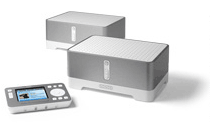 Switched On: The musical mesh for the moneyed - Engadget - www.engadget.com
Switched On: The musical mesh for the moneyed - Engadget - www.engadget.comSwitched On: The musical mesh for the moneyed
Posted Aug 17, 2005, 2:50 PM ET by Peter Rojas
Related entries: Features, Home Entertainment
Every Wednesday Ross Rubin contributes Switched On, an opinion column about consumer technology, multimedia, and digital entertainment:
Over the past few years, more than 20 products have sought to bridge the gap between the growing libraries of PC-based music and the rest of the home. Most of these have been point solutions that lump music in with photos and videos for delivery from computer “A” to television “B”. Some, like Slim Devices’ SqueezeBox, focus only on music and even come with server software that can serve the same music to multiple devices simultaneously. But the Sonos Digital Music System takes a fundamentally different approach, using a mesh network to deliver music to multiple rooms. Sonos does this using shoebox-sized receivers called ZonePlayers that connect to off-the-bookshelf speakers.
The hallmark of the Sonos system is simplicity. Music can be stored on a PC, Mac, or – since the system doesn’t require any server software — network-attached storage volume. Setup is straightforward, although you may have to do some running back and forth between the hefty (they include an amplifier) white ZonePlayers if you’re doing it alone. Once it is up and running, the Sonos system is surprisingly responsive. Music starts playing instantly, even faster than it would from a local CD that required spin-up time.
The star of the Sonos system is its wireless remote controller, which acts as just another node on the Sonos network. Its illuminated buttons and large color LCD display steals attention from just about anything else on your coffee table while its white scroll wheel steals from something else. Unfortunately, the scroll wheel doesn’t have the same acceleration sensitivity as Apple’s, but it improves upon the iPod’s interface with dedicated volume buttons.
Because the remote is a full peer in the network, you can do anything with it that you can do with the PC or Mac software, including updating the entire system. Indeed, after identifying an update from the remote, the Sonos system downloaded it and in turn seamlessly updated both ZonePlayers in sequence without intervention. This demonstrated Sonos’s hassle-free and network-centric design impressively.
Keeping the control of music close by is a hands-down improvement over the limited LED and TV-based displays of many less-expensive competitors. However, using the remote is a two-handed commitment, queue management is a bit Paleolithic (and by that I don’t mean that it excels with rock music), and the system could do a better job of providing more context around songs in a playlsit.
There are other Sonos “Oh no’s”. Because the company uses a proprietary wireless networking technology, the first ZonePlayer is supposed to be connected to your router or a PC via a wired connection. For those without twisted-pair Ethernet running through their walls, that’s a waste of a $500 component. Sonos could rectify this by creating a less expensive proprietary wireless bridge between the router and other ZonePlayers. While Sonos hosts a Web forum in which to discuss various third-party Ethernet bridges as workarounds, none are officially supported.
Second, the ZonePlayer doesn’t support powered audio. At one time, this would have been a non-issue with the low quality of many multimedia speakers. However, today’s high–end offerings now include such products as Logitech’s 200-watt THX-certified Z-300, which would make a compact companion for a ZonePlayer in many a bedroom. Unfortunately, this is probably the kind of revision that would require upgrading hardware, but Sonos says it is very high on the priority list.
Finally, when it comes to remote controls, one is the orneriest number. Wireless remotes can easily get misplaced or spark family feuds that would frighten Richard Karn more than a visit from the ghost of Ray Combs. Sonos should consider creating stationary remotes that could offer a simplified interface; these could accommodate other family members or provide a backup while the wireless remote was charging.
Despite these Version 1.0 gaps, Sonos’ approach offers many lessons for a flagging home audio market that has lost its midrange support like a broken speaker. At $1,200 for a bundle that includes two ZonePlayers and a wireless remote, it is hardly a budget offering and over time the advantages offered by a proprietary network may be outweighed by liabilities. However, Sonos has executed very well in its first offering with a philosophy and focus that is turning the company’s customers into fans.
Ross Rubin is director of industry analysis at NPD Techworld, a division of market research and analysis provider The NPD Group. Views expressed in Switched On, however, are his own. Feedback is welcome at fliptheswitch@gmail.com.




